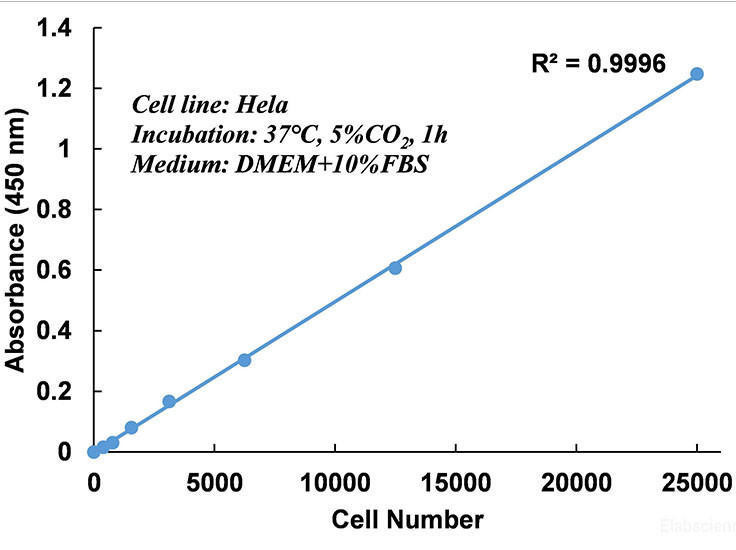3D Organoid Cell Viability Assay: Performance Assessment in Human Colon Organoids
The 3D Organoid Cell Viability Assay (AKES081) demonstrated high sensitivity and low cytotoxicity, making it ideal for long incubation studies (24-48 hours) and high-throughput applications. AKES081 effectively quantified live cell numbers in human colon organoids using WST-8 reduction, providing a direct correlation between viability and optical density at 450 nm. AKES081 confirmed expected cytotoxic effects of 5-fluorouracil (5-FU), with decreasing organoid survival at increasing drug concentrations, validating its suitability for drug screening applications. The one-step, wash-free protocol enabled easy viability assessment and allowed for subsequent RNA extraction for gene expression analysis, maximizing experimental efficiency. AKES081 provided consistent results with minimal error, making it an excellent tool for working with organoid cultures, particularly when sample availability is limited.
Key Findings:
- The 3D Organoid Cell Viability Assay (AKES081) demonstrated high sensitivity and low cytotoxicity, making it ideal for long incubation studies (24-48 hours) and high-throughput applications.
- AKES081 effectively quantified live cell numbers in human colon organoids using WST-8 reduction, providing a direct correlation between viability and optical density at 450 nm.
- AKES081 confirmed expected cytotoxic effects of 5-fluorouracil (5-FU), with decreasing organoid survival at increasing drug concentrations, validating its suitability for drug screening applications.
- The one-step, wash-free protocol enabled easy viability assessment and allowed for subsequent RNA extraction for gene expression analysis, maximizing experimental efficiency.
- AKES081 provided consistent results with minimal error, making it an excellent tool for working with organoid cultures, particularly when sample availability is limited.
3D Organoid Cell Viability Assay: Performance Assessment in Human Colon Organoids
Introduction
To evaluate the efficiency of the AssayGenie 3D Organoid Cell Viability Assay, we conducted a test on human colon organoids. This report presents the results and performance of this kit under our experimental conditions.
Assay Principle
The Assay Genie 3D Organoid Cell Viability Assay is a highly sensitive, 1-step kit to quantify the number of live viable cells directly in cell culture supernatants and 3D Organoid models.
This kit is an excellent choice for proliferation and cytotoxicity studies and been validated in 2D cell culture as well as Apical-Out airway organoids in a highthroughput 384-well format.
This technology is based on the reduction of WST-8 Tetrazolium salt by mitochondrial dehydrogenases to an orange product which is directly proportional to the number of viable cells when measured at 450nm.
WST-8 is highly soluble in cell culture medium with a low cytotoxicity profile and can be added directly to cultured cells with no pre-treatments or wash steps.
It is extremely powerful for high-throughput and sensitive experiments especially those requiring longer incubation steps such as 24 hour or 48 hours.
This kit offers a much higher sensitivity and lower cytotoxicity than other Tetrazolium reagents such as MTS, MTT, PrestoBlue or XTT.
Methods
Day 1 – Seeding:
Human colon organoids were seeded in 20 μL Matrigel domes in a 24-well plate, with each dome containing 60% Matrigel. Three wells were reserved for Matrigel alone to measure background noise.
Day 2 – Treatment with 5-FU:
The organoids were treated with two concentrations of 5- fluorouracil (5-FU): 25 μM and 50 μM in a final volume of 500 μL per well. Each condition was performed in triplicate to ensure reproducibility of the results.
Day 5 – Addition of the AssayGenie 3D Organoid Cell
Viability Reagent:
The medium was replaced with 300 μL of fresh medium, and 5 μL of the 3D Organoid Cell Viability reagent was added to each well. The plates were then incubated for 24 hours under normal culture conditions.
Day 6 – Reading the Results:
The supernatant from each culture (100 μL) was collected and transferred to a 96-well plate for measurement. The optical density (OD) was measured at 450 nm. The background noise, determined from the wells containing only Matrigel, was subtracted to calculate the percentage of cell survival.
Page 1
Results

Effect of 5-fluorouracil (5-FU) on the survival of human colon organoids. Different concentrations of 5-FU were used (Control, 25 μM, 50 μM).
Each data point represents an average of three experiments (biological triplicates). The error bars, though present, are very small and thus barely visible on the graph.
Conclusion
The results show the expected decrease in organoid survival with increasing concentrations of 5-FU, confirming the reliability of the Assay Genie kit for evaluating cell viability.
The kit is easy to use and offers great flexibility, also allowing RNA extraction for subsequent gene expression analysis by qPCR. In conclusion, the Assay Genie 3D Organoid Cell Viability Assay has proven to be an effective tool, providing reliable and reproducible results while allowing multiplex analysis.
This is essential for optimal use of organoid cultures, as they are generally available in limited quantities.
Page 2
Meet Some of the Genie Team!
Recent Posts
-
Department of Oncology Retreat 2025
Department of Oncology RetreatAssay Genie was honoured to sponsor and participate in t …30th May 2025 -
Cure CLCN4 2025
Cure CLCN4 2025Assay Genie was honored to attend and present at the 2025 Cure CLCN4 Sc …26th May 2025 -
Alemtuzumab: Mechanism, Applications, and Biosimilar Advancements
Quick Facts About AlemtuzumabWhat is Alemtuzumab?Alemtuzumab is a monoclonal antibody …26th May 2025





















